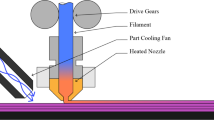Abstract
Due to its ease of application, Fuji prescale pressure-sensitive film is currently one of the more popular methods, within the biomechanics community, for assessing contact areas and pressures within articulating joints—in addition to its use in industry. This material produces a stain on the application of pressure due to the rupture of microscopic bubbles releasing a liquid which, in turn, causes patches of color to be formed; a greater pressure produces a darker stain. These stains are often converted into digital images and manipulated to produce false-color pressuremaps, an approach which is beyond the simple methods of analysis suggested by the manufacturer. Due to the granular nature of Fuji film stains, the two user-defined variables which will determine the accuracy of any pressure-map are: (a) the size of the sample-area used to capture data from the original stain during the digitization process and (b) the number of pressure-intervals identified on each map; the chosen values should match the spatial and pressure resolutions of the film. Despite the importance of these factors, the literature presents a bewildering array of values, particularly for the number of pressure-intervals, with no validation of those chosen; consequently, little guidance is provided for other potential users of Fuji film. This paper discusses the relationship between sample-area and pressure-interval and introduces a method for examining their effect on the resulting pressure-maps. The results obtained using ‘Super Low’ grade Fuji film suggest that the authors of some previously reported methods may have been overambitious in their choice of sample-area and pressure-intervals. Finally, a series of suggested values of sample-area size and pressure-intervals are provided.
Similar content being viewed by others
References
Liggins, A.B. andFinlay, J.B., “Recording Contact Areas and Pressures in Joint Interfaces,”Experimental Mechanics: Technology Transfer Between High Tech Engineering and Biomechanics, ed. E.G. Little Elsevier Science Publishers, Amsterdam, 71–88 (1992).
Stormont, T.J., An, K.N., Morrey, B.F. andChao, E.Y., “Elbow Joint Contact Study: Comparison of Techniques,”J. Biomech.,18 (5),329–336 (1985).
Simon, W.H., “Scale Effects in Animal Joints,”Arth. Rheu.,13 (3),244–255 (1970).
Manouel, M., Pearlman, H.S., Balakhlef, A. andBrown, T.D., “A Miniature Piezoelectric Polymer Transducer for in vitro Measurement of the Dynamic Contact Stress Distribution,”J. Biomech.,25 (6),627–635 (1992).
Inaba, M. andArai, M., “A Method for Measuring Contact Pressures Instantaneously in Articular Joints,”J. Biomech.,22 (11),1293–1296 (1989).
Ahmed, A.M. andBurke, D.L., “In-vitro Measurement of Static Pressure Distribution in Synovial Joints-Part I: Tibial Surface of the Knee,”J. Biomech. Eng.,105,216–225 (1983).
Frisina, W. andLehneis, HR., “Pressure Mapping: A Preliminary Report,”J. Biomech.,3 (6),526–528 (1970).
Bourgois, R. andBel, J., “A New Cheap Pressure Foil,”Strain,29 (1),27–28 (1993).
Afoke, N.Y.P., Byers, P.D. andHutton, W.C., “Contact Pressures in the Human Hip Joint,”J. Bone and Joint Surg.,69B (4),536–541 (1987).
Haut, RC., “Contact Pressures in the Patellofemoral Joint During Impact Loading on the Human Flexed Knee,”J. Orthop. Res.,7 (2),272–280 (1989).
Fukubayashi, T. andKurosawa, H., “The Contact Area and Pressure Distribution Pattern of the Knee: A Study of Normal and Osteoarthrotic Knees,”Acta Orthop. Scand.,51,871–879 (1980).
Hehne, H.J., Ficker, E., Jantz, W., Mahr, D. andSchopf, HJ., “A New Method for Measurements of Pressure Distributions and Contact Areas in Joints,”Morphol. Med.,1,95–106 (1981).
Wagner, U.A., Sangeorzan, B.J., Harrington, R.M. andTencer, A.F., “Contact Characteristics of the Subtalar Joint: Load Distribution Between the Anterior and Posterior Facets,”J. Orthop. Res.,10 (4),535–543 (1992).
Werner, F.W., Murphy, D.J. andPalmer, A.K., “Pressures in the Distal Radioulnar Joint: Effect of Surgical Procedures Used for Kienbock's Disease,”J. Orthop. Res.,7 (3),445–450 (1989).
Tencer, A.F., Viegas, S.F., Cantrell, J., Chang, M., Clegg, P., Hicks, C., O'Meara, C. andWilliamson, J.B., “Pressure Distribution in the Wrist Joint,”J. Orthop. Res.,6 (4),509–517 (1988).
McNamara, J.L., Collier, J.P., Mayor, M.B. andJensen, R.E., “A Comparison of Contact Pressures in Tibial and Patellar Total Knee Components Before and After Service in vivo,”Clin. Orthop.,299,104–113 (1994).
Singerman, R.J., Pedersen, D.R. andBrown, T.D., “Quantitation of Pressure-sensitive Film Using Digital Image Scanning,”Experimental Mechanics,27 (1),99–105 (1987).
Ronsky, J.L., Herzog, W., Brown, T.D. andLeonard, T., “In-vivo Determination of Patellofemoral Joint Contact Pressures,”J. Biomech.,26 (3),352 (1993).
Brown, T.D., Pope, D.F., Hale, J.E., Buckwater, J.A. andBrand, R.A., “Effects of Osteochondral Defect Size on Cartilage Contact Stress,”J. Orthop. Res.,9 (4),559–567 (1991).
Hehne, H.J., Haberland, H., Hultzsch, W. andJantz, W., “Measurements of Two Dimensional Pressure Distributions and Contact Areas of a Joint Using a Pressure Sensitive Foil,”Biomechanics: Principles and Applications, ed. R. Huiskes, D.H. Van Campen andJ.R. De Wijn Martinus Nijhoff, The Hague, 197–203 (1982).
Sangeorzan, B.J., Wagner, U.A., Harrington, R.M. andTencer, A.F., “Contact Characteristics of the Subtalar Joint: The Effect of Talar Neck Misalignment,”J. Orthop. Res.,10 (4),544–551 (1992).
Hale, J.E. andBrown, T.D., “Contact Stress Gradient Detection Limits of Pressensor Film,”J. Biomech. Eng.,114 (3),352–357 (1992).
Pan, H.Q., Kish, V., Boyd, R.D., Burr, D.B. andRadin, E.L., “The Maquet Procedure: Effect of Tibial Shingle Length on Patellofemoral Pressures,”J. Orthop. Res.,11 (2),199–204 (1993).
Marder, R.A., Swanson, T.V., Sharkey, N.A. andDuwelius, P.J., “Effects of Partial Patellectomy and Reattachment of the Patellar Tendon on Patellofemoral Contact Areas and Pressures,”J. Bone and Joint Surg.,75A (1),35–45 (1993).
Liggins, A.B., Stranart, J.C.E., Finlay, J.B. andRorabeck, C.H., “Calibration and Manipulation of Data from Fuji Pressure-sensitive Film,”Experimental Mechanics: Technology Transfer Between High Tech Engineering and Biomechanics, ed. E.G. Little, Elsevier Science Publishers, Amsterdam, 61–70 (1992).
Caldwell, N.J., Hale, J.E., Rudert, J.M. andBrown, T.D., “An Algorithm for Approximate Crinkle Artifact Compensation in Pressure-sensitive Film Recordings,”J. Biomech.,26 (8),1001–1009 (1993).
Wonnacott, T.H. andWonnacott, R.J., Introductory Statistics, 5th Ed., John Wiley and Sons, Toronto, 266 (1990).
Author information
Authors and Affiliations
Rights and permissions
About this article
Cite this article
Liggins, A.B., Hardie, W.R. & Finlay, J.B. The spatial and pressure resolution of fuji pressure-sensitive film. Experimental Mechanics 35, 166–173 (1995). https://doi.org/10.1007/BF02326476
Received:
Revised:
Issue Date:
DOI: https://doi.org/10.1007/BF02326476




